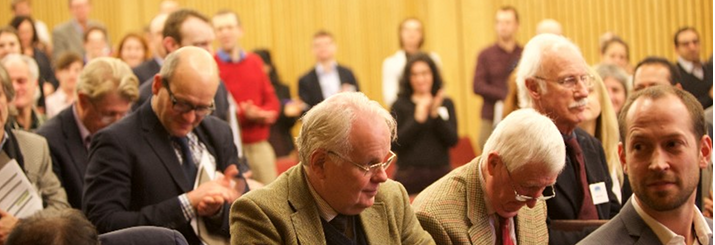
The British Neuropsychiatry Association (BNPA) brings together psychiatrists, neurologists, neuropsychologists and other professionals interested in the brain and mind. Its annual meeting aims to increase, integrate, and disseminate understanding of the relationships between brain function and human behaviour. This year, the two key themes of the meeting were language and neurodevelopmental perspectives on adult disorders. An eclectic range of talks illuminated these themes from a variety of perspectives, both clinical and academic, but space only allows discussion of a few of these. Three clinical highlights have been chosen that might change your practice, and three fascinating scientific presentations that may tempt you to find out more about a new area.

Clinical highlights
1. The genetics of epilepsy, Prof Sanjay Sisodiya
In discussing the genetics of epilepsy, Sanjay Sisodiya gave a clear overview of an enormously complex field. In particular, he drew attention to examples of where a genetic diagnosis can have real treatment implications for someone with epilepsy. Dravet’s syndrome, caused by mutations in the SCN1A sodium channel gene, should be suspected in cases previously labelled as “vaccine encephalopathy”. There is typically a history of febrile seizures and apparent developmental regression and then stabilisation. These patients are made much worse by sodium channel blocking anti-epileptic drugs.
2. Adult ADHD, Prof Philip Asherson
Philip Asherson convinced the audience that ADHD is not only a valid diagnostic entity in children, but also an under-diagnosed problem in the adult population which might come to the attention of both psychiatrists and neurologists. There is very significant comorbidity with other psychiatric disorders and emotional instability may be part of the syndrome, along with more classical features of inattention. There is high quality evidence for the efficacy of both amphetamines and atomoxetine in adults with ADHD.
3. Primary progressive aphasias, Dr Jonathan Schott
Jonathan Schott gave a systematic account of the clinical and radiological hallmarks of the three subtypes of primary progressive aphasia, and the correlation with underlying neuropathology. Progressive non-fluent aphasia causes effortful speech, orofacial apraxia and phonemic paraphasias, with subtle left posterior fronto-insular atrophy and can be caused by a range of different pathologies. Semantic dementia causes fluent, circumlocutory speech, surface dyslexia, and often behavioural disturbance, with obvious left anterior temporal atrophy and underlying TDP-43 type C pathology. In logopenic aphasia, there are word-finding pauses, severe anomia and impaired sentence repetition with subtle left peri-sylvian or parietal atrophy and almost always Alzheimer disease pathology.
Research highlights
1. Gut microbes and brain function, Prof Ted Dinan
Ted Dinan is an academic psychiatrist with a long-standing interest in the role of gut microbiota in stress-related disorders. He explained that mice in a “germ-free” environment show an altered cortisol response to stress and abnormal behaviour, and that mice subjected to the maternal separation model of depression develop a narrowed gut microbiota. Faecal transplants to rats from depressed subjects (but not controls) cause anhedonia and an inflammatory response. Specific probiotics may improve behavioural measures of anxiety in animal models.
2. Face, brain and behaviour, Prof Peter Hammond
Peter Hammond, a computational biologist, achieved the remarkable feat of making mathematical modelling both comprehensible and clinically relevant. His work on 3-dimensional facial photography provides a new diagnostic tool for suspected fetal alcohol syndrome. Fascinatingly, deletions and duplications in the same genomic region may have “opposite” effects on facial morphology.
3. Bilingualism and the brain, Prof Thomas Bak
Thomas Bak provided an overview of language as an introduction to the second day of the meeting, but his work on the clinical relevance of bilingualism was particularly intriguing. Being bilingual seems to delay the onset of dementia by several years, and to improve functional recovery following stroke. A two week foreign language course in healthy individuals can improve performance in unrelated cognitive domains.
This year’s JNNP guest lecture by Prof Francesca Happe provided an authoritative overview of autism spectrum disorders and highlighted the fascinating combination of strengths and weaknesses that autism presents. People with autism seem to lack “central coherence”, the drive to pull information together for the “big picture”, but have very strong attention to detail. The BNPA medal was awarded to Chris Frith, whose talk on the benefits of group decision making prompted BNPA president Alan Carson to comment that he seems to be achieving more in retirement than most of us do in our peak years! Founding member of the BNPA Professor Alwyn Lishman delighted delegates by speaking on the history of the organisation.
Finally, the meeting was rounded off with a debate between Alasdair Coles (Cambridge) and Anil Seth (Sussex) discussing the motion “Is there still room for a soul in the modern concept of the psyche”. Alasdair was working to an early advantage, with 50 people for and 25 against the motion prior to the debate. He built on this with a description of the soul to include that part of us which communicates with the divine and not necessarily an immortal part of us that lives on after our death. Anil, by comparison, built on the concept that the popular description of the soul was of something separate from the body, and that this division was not helpful for advancing our knowledge of the brain. In the end, Alasdair’s technical argument regarding definitions lost out to Anil’s more persuasive holistic argument – resulting in Anil winning 30 to 25 votes, a close and entertaining debate.
The BNPA meeting is not just for neuropsychiatrists, but for those of all disciplines interested in the grey area between brain and mind. The next annual meeting in February 2017 is sure to be equally stimulating.
ACNR 2015;16(2):26-27. Published online 14/6/16
To Cite: Stanton B, ACNR 2016; 16 (1)